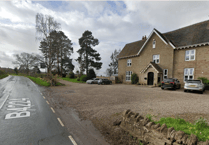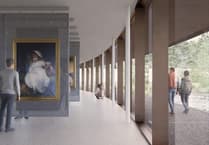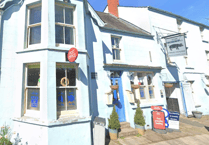It was a déjà vu moment vividly recalling the glorious summer afternoon that my walking companion and poet Peter Gibbs and I sat on a seat eating ice cream at Great Haywood Junction while walking The Tent and Mersey Canal
While brightly painted narrowboats puttered past there were crowds of folk everywhere enjoying the sunshine.
Now it was early on a freezing cold January morning without a soul in sight and we were setting out to walk the Staffordshire and Worcestershire canal which links Great Hayood with Stourport on Severn.
This delightfully rural forty-six mile long waterway, opened in 1777 to carry goods from The Potteries west to Gloucester and onward down the River Severn to the bustling seaport and city of Bristol, was the latest piece in the jigsaw of canal walks which we had been completing over the past twenty years.
The sky was ominously overcast and the towpath muddy and slippery as we started trudging the first eleven miles to our overnight stop in the small market town of Penkridge.
We had not gone far when we came upon a cluster of early primroses together with a small wooden plaque placed there by a small group of locals giving thanks for surviving the Covid epidemic.
While bare branched trees cast skeletal reflections over the still waters, the distinctive cries of wild geese came drifting over on the still air from nearby water meadows and the now waterlogged flood plains of the River Sow.
I was an early disappointment that this canal had no distinctive metal markers to help us count down the miles to our day’s journeys end. But by way of a small compensation all its lovely old stone bridges were individually named instead of simply numbered and this we had not seen before,
We were also interested to find that many of the old metal strips used at the end of the bridges to protect the stonework from the horse-drawn barge towing ropes were still there, together with the grooves that had been made in them over the years.
By early afternoon the BBC weather girl’s forecast sun put in a late appearance, but was low in the sky and also reflecting off the water which made picking our way along the slippery towpath directly into its blinding light particularly difficult.
Six hours if walking all through open country with the quite heavy packs on our backs and with only two passing narrow boats and a handful of dog walkers for company, brought us at last to Penkridge and a warm welcome at The Littleton Arms, a grade two listed 18th century coaching inn where we were booked in for the night.
Regaining the canal early the following morning, there was now an icy golden sheen on the water as we crunched along the frozen towpath, but hang on minute; why was the rising sun still shining directly into our eyes?
Then the penny dropped because the previous afternoon, and without our noticing it, the towpath had swung around from west to east before correcting itself a mile or so further on.
By coffee time we had reached Gailey Lock and the 340-ft summit of the Staffs and Worcs Canal, having now climbed 150 ft from Great Haywood Junction and here overlooking the top lock we came upon a magnificent roundhouse dating back to the year of Trafalgar.
It is thought to have been inspired by the Martello Towers built as a defensive measure during the Napoleonic Wars.
Again we had this peaceful rural landscape under clear blue winter skies entirely to ourselves until we came upon a most welcome sight, namely The Anchor Inn at Cross Green, on the outskirts of Wolverhampton where ‘muddy boots were welcome.
The sandwiches we had bought earlier would now have to wait until tomorrow we decided, before entering for lunch.
Back on the canal we continued walking for an hour or so before diverting via a lane and a series of busy roundabouts to reach our Premier Inn at Wolverhampton North.
The prospect of risking life and limb by attempting to retrace our steps in the morning rush hour was not a good idea so we booked a taxi to take us on to the next canal bridge.
But it snowed heavily overnight which inevitably delayed our departure and when at last we reached our drop off point there was no canal to be seen!
Luckily a local called Roger was able to point out the right direction and we were soon back on course and following a surprising rural way out of the city along a linear park under now clear blue skies and a dazzling white towpath underfoot.
Passing junctions with the Shropshire Union, a completed piece in our jigsaw and the Birmingham canals, we were quickly out into open and sometimes wooded country amid low hills.
Just above Compton Lock, we came upon the first of a series if distinctive stone- built and circular Lobsterpot weirs designed by famous Victoria canal builder and engineer, James Brindley, to prevent tree branches and other debris entering his water channels.
We picnicked against a sunny wall before setting out on our afternoon walk to Wombourne and here on leaving the canal, we faced a 1.7-mile tramp up a busy main road, but luckily help was at hand with the appearance of a waggon and horses.
It was, of course, an inn and five minutes later, we were enjoying a rest and a drink and waiting for a local taxi driver to take us to the 17th century Himley House Hotel and then back to the path in the morning.
Our final day on the walk was to prove to be the most scenic of all and we’d not gone far when we came upon ‘fisherman’ Andy Timmins from Dudley beside a lock. But he was using a hand-held line with magnet on the end and was not at all interested in fish.
He had recently recovered three Roman coins. but sadly, they had turned out to be fake.
The canal now began forging its way between low and wooded hills, along a series of shallow valleys and through patches of quiet woodland until we arrived in the village of Kinver and The Vine Inn for lunch.
That afternoon the canal led us through more delightful countryside into Worcestershire and beyond to Kidderminster where we were treated to a magnificent late afternoon waterside view of the town’s Grade One listed St Mary and All Saints parish church.
We stayed overnight at another nearby Premier Inn before setting out on the final three-miles walk into Stourport on Severn,
The rising sun casting a golden glow over the water and setting the bordering bracken ablaze as the canal wound its way around a wooded hillside, was spectacular and made a fitting finale to our latest adventure.





Comments
This article has no comments yet. Be the first to leave a comment.